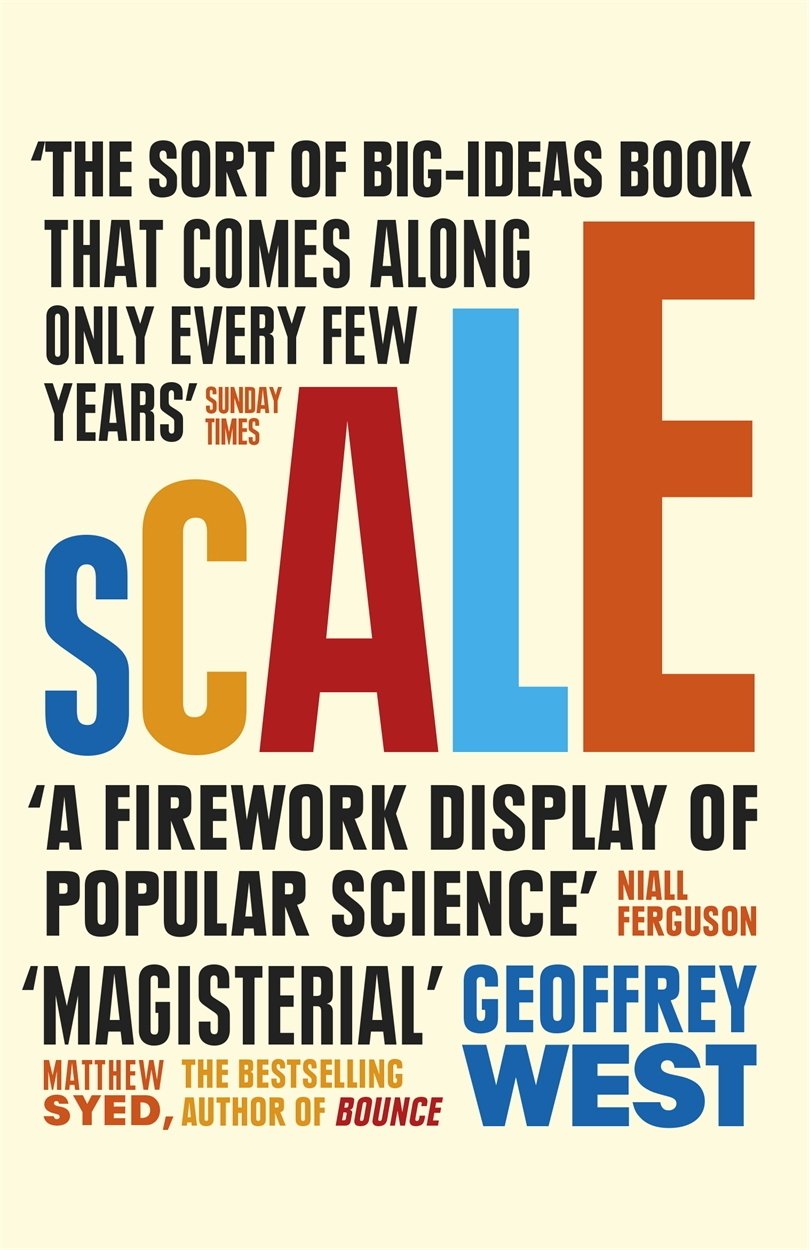quoting naddr1qq…9m6m𝗦𝗰𝗮𝗹𝗲: 𝗧𝗵𝗲 𝗨𝗻𝗶𝘃𝗲𝗿𝘀𝗮𝗹 𝗟𝗮𝘄𝘀 𝗼𝗳 𝗟𝗶𝗳𝗲, 𝗚𝗿𝗼𝘄𝘁𝗵, 𝗮𝗻𝗱 𝗗𝗲𝗮𝘁𝗵 𝗶𝗻 𝗢𝗿𝗴𝗮𝗻𝗶𝘀𝗺𝘀, 𝗖𝗶𝘁𝗶𝗲𝘀, 𝗮𝗻𝗱 𝗖𝗼𝗺𝗽𝗮𝗻𝗶𝗲𝘀 𝗯𝘆 𝗚𝗲𝗼𝗳𝗳𝗿𝗲𝘆 𝗪𝗲𝘀𝘁
This book is a wonderfully cross-disciplinary exercise in fractal discovery and insight onto our world - initially the result of the author’s pondering his own mortality which led to a study of longevity across organisms, and then expanded to social structures like cities and companies.
In the book, “scale” itself, conceptually, is defined as “how systems respond to changes in size.” Does doubling an animal’s dimensions increase its relative strength? Does doubling a city’s size double it’s relative rate of crime? These 2 questions introduce the key distinctions between sublinear scaling (the larger the thing, the relatively less of some characteristic it has) and superlinear scaling (the larger the thing, the relatively more of some characteristic it has), respectively.
Organisms, we discover, scale sublinearally - larger animals are more efficient requiring less energy per unit of weight, but similarly they become, relatively structurally weaker as size increases - this is why Godzilla cannot exist, he would collapse under his own weight! Further, biological metabolic rates scale sublinearlly to size, so as the organism grows, energy demands of cellular maintenance outstrips supply leading to cessation of growth and eventual death (we also find companies face a similar fate, with “costs” replacing cellular maintenance).
Cities, however, are more interesting. In terms of infrastructure they scale like organisms (sublinearlly), but in terms of emergent human outputs, they scale superlinearlly - the larger the city, the relatively more patents, companies, GDP, crime, and disease it will host. For cities, superlinear scaling of those emergent human properties, or “social metabolism” results in the creation of social capital increasingly outpacing the demands of maintenance (those being largely infrastructural) suggesting accelerating, unbounded, open-ended growth.
With regard to growth, superlinearity results in exponential growth, which the author approaches as a terrifying and dark mathematical horror. He illustrates this with what I found to be the book’s most illuminating vignette…
SCENARIO: It is 11:00. A petri dish 🧫 contains a single bacteria🦠 cell. This bacteria will double every minute. The petri dish will be completely full in 1 hour. At what time is the petri dish 🧫 50% full?
If you said anything other than 11:59, you’ve missed the key implication of exponential growth. Exponential growth is slowly, then all at once. But let’s double down on this to really underscore that point - at what time does the petri dish in the aforementioned scenarios become just 1% full? The answer is somewhere between 11:53 and 11:54. Reflect on that.
What might this kind of acceleration in growth mean for technological advancement? For human population and biosphere carrying capacity? For resource consumption? And for how all of these things interrelate and impact each other? Quite thankfully, the book rejects Malthusianism. While still raising legitimate questions about the math of an exponentially expanding Earthbound civilization’s sustainability, the author rightfully points to the imperative to harness nuclear and solar energy at-scale as our best hopes to sustain requirements both continuous population and technological acceleration.
Finally, the examination of exponentiality brings us to the deepest conundrum identified in the book - the finite time singularity - where unbounded growth cannot sustain without either (1) infinite energy or (2) paradigm shift “reset” that temporarily staves off system collapse. But wait! There’s more! The mathematics of superlinearity suggest that, in absence of infinite energy, the chain of paradigm shift resets are themselves required to happen at an ever faster and faster pace, or at shorter and shorter intervals.
So, if we are confined to Earth’s closed system, the need for continuous and unending paradigm shift innovations at ever-shorter intervals eventually manifests a meta-finite time singularity, the essential singularity which is perhaps, inescapable. The core insight to be extrapolated here is that if we are to overcome the singularity trap, we must drive real, constant step-function innovation and that this innovation must, almost necessarily, allow us to progressively harness orders of magnitude more energy than today - think Dyson Spheres, interstellar / intergalactic travel, quasar bitcoin mining, and so on.
CONCLUSION: Dense yet whimsical, lengthy yet very fun. Questing and questioning cover to cover. Great for anyone interested in inter-disciplinarianism and fractal thinking (the long practice of which I find lends to heightened levels of predictive intuition) (4.5/5☢️)
https://www.amazon.com/Scale-Universal-Growth-Organisms-Companies/dp/014311090X
#Bitcoin #Plebchain #Coffeechain #Books #Bookstr #Nostr #NostrLove #GrowNostr #Writestr #Createstr

Roland
npub1el…s58z4
2025-05-01 06:42:24
Author Public Key
npub1elchyrnhhvrg7r4m6wyae4ggytw34jxj4s9s7hcgqzhfu9w8u2eq9s58z4